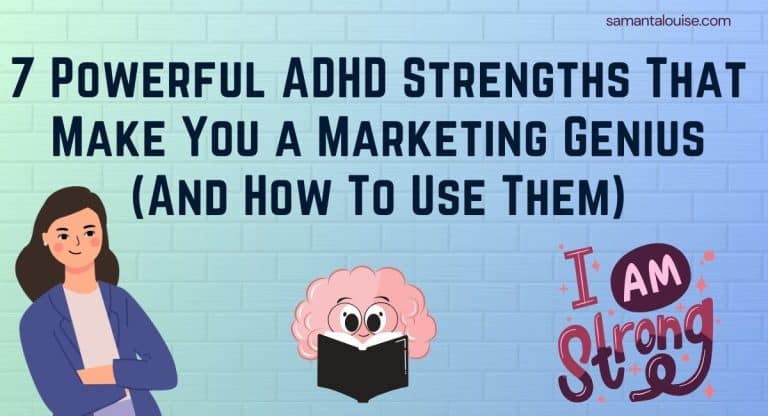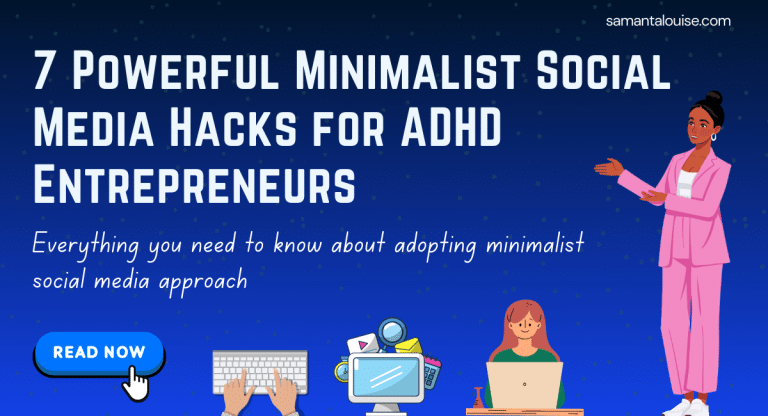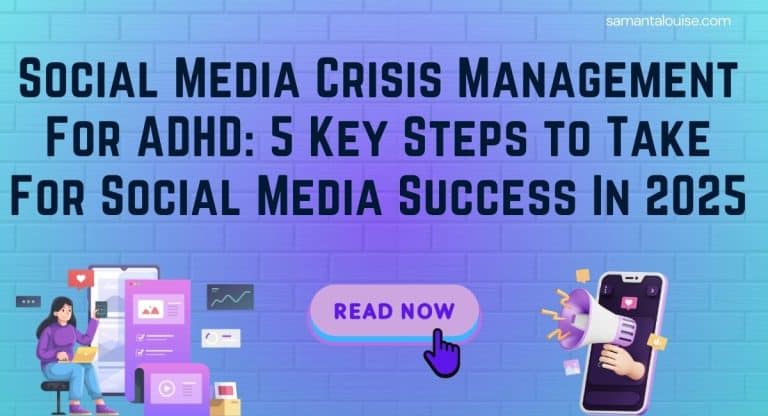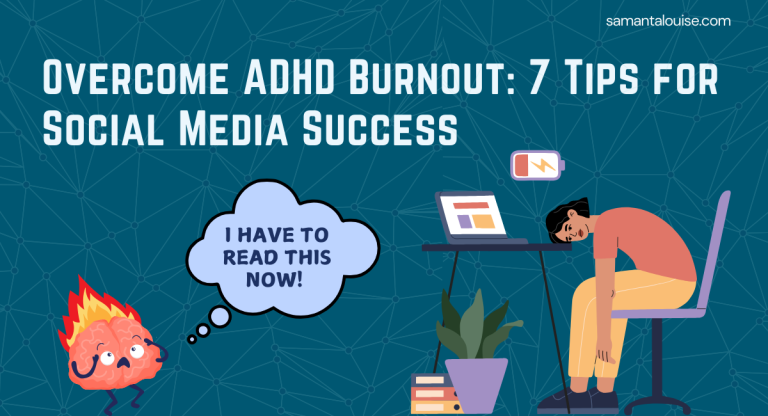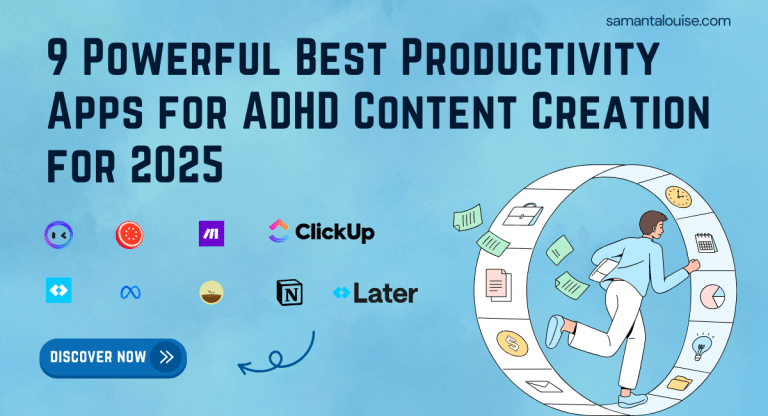Mastering Social Media Marketing for ADHD Entrepreneurs in 2024: The Ultimate Guide To Success
Have you ever felt stuck between getting things done and dreaming up the next big viral piece of content for your account?
You might not be the only one…
Suppose you ever felt afflicted by perfectionism in content creation, imposter syndrome in your marketing career, a burst of impulsiveness in your social media strategies, and an inability to stay consistent in your social media marketing efforts. In that case, this social media marketing for ADHD entrepreneurs guide is for you!
As a certified digital marketer with ADHD, I spent a great deal of my time looking for the best ADHD-friendly social media tools, productivity hacks, and strategies to ease my job as a digital marketer.
In this guide, I will walk you through the best techniques and strategies to make your life easier as a social media marketer with ADHD.
Let’s get right into it!
Use the table of contents below to navigate this social media marketing for ADHD entrepreneurs guide
Table of Contents
Understanding the ADHD Advantage in Social Media Marketing
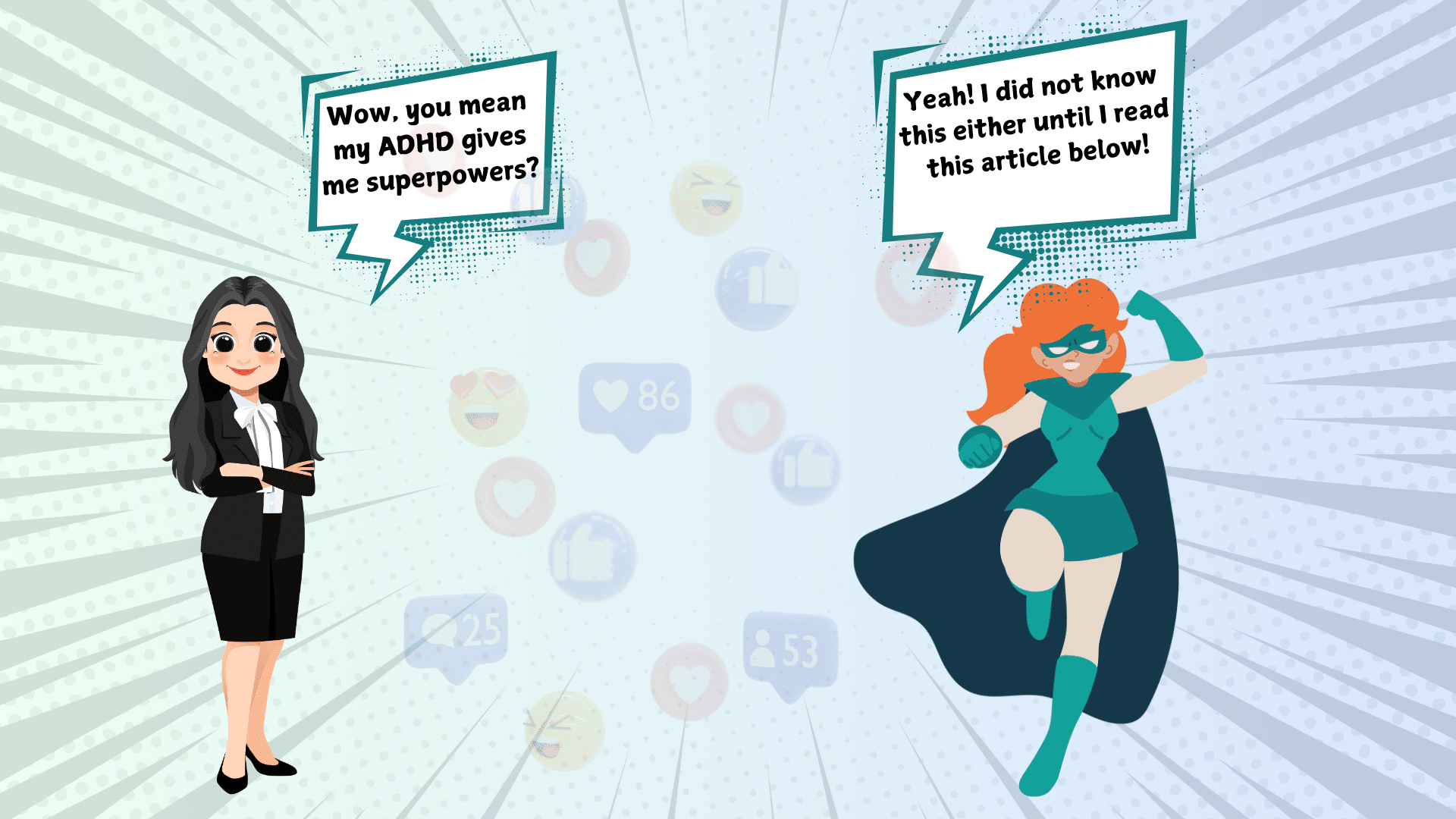
Ever since I knew I had ADHD, I had been bombarded with claims of how my ADHD was actually an advantage throughout my life.
Initially, it made me upset because I used to think “How can this be even an advantage?”
But over time, I changed my perspective and rather than seeing ADHD as a disadvantage, I started to look at its symptoms as advantages.
The superpowers of the ADHD brain
1. Imagination and creativity
The ADHD brain and creativity are linked in many ways, and one of them is the ability to think outside the box and imaginatively connect the dots. Experts call it divergent thinking. Social media marketing is one of the many perfect fields to exercise this creative side of you daily.
As a social media marketer, you can leverage this trait to brainstorm new ideas that can turn into innovative masterpieces that can go viral on social media.
The ability to visualize stories helps create appealing graphics and videos that captivate your audience.
2. Hyperfocus
Feeling stimulated by the idea of doing multiple things at the same time is a common trait of individuals with ADHD but one salient trait of ADHD that works wonders for social media marketers is the ability to dive deep into topics of interest.
Whether it is that new content calendar you have to put up together or audience research, hyperfocus can help you stay on top of the game.
Social media batching techniques can help you stay productive and thrive in your social media marketing efforts. With effective strategies, you can turn your hyperfocus episodes into a powerhouse of productivity and creativity.
3. Keen observation and adaptability
Ever heard of that saying “Your brain is like a Ferrari”? It has the engine of a race car but the brake of a pushbike. What could be seen as a disadvantage is actually a blessing in disguise.
Successful individuals like Richard Branson and Simone Biles have successfully turned their lives around despite having ADHD by utilizing their creative, innovative and swift minds to adapt and make a difference in the world. They have empowered people with ADHD to shift the overly pessimistic narrative and to start embracing the ADHD brain.
If you learn how to strengthen these brakes by using effective strategies, your social media marketing career could be in for pleasant surprises and growth.
Quick Takeaway Points
- Divergent thinking is your best friend in content creation – use it to ideate and create innovative content
- Use your imagination and creativity for brainstorming and visual storytelling
- Hyperfocus in content creation can lead to more productivity and creativity
- Use social media focus techniques such as content batching to take full control of your content schedule
- Adaptability and keen observation can help social media marketers with ADHD to pivot quickly and have more resilience in the workplace.
Crafting an ADHD-Friendly Social Media Strategy
The word “strategy” is used everywhere and might appear intimidating but it is actually quite simple. So, what exactly is a strategy?
Let me break it down for you; imagine you are planning a trip abroad, to ensure everything goes smoothly, you would have to take care of three things:
- Where to go
- How to get there
- What steps to take to ensure your trip goes well with the available budget
This is exactly what a strategy is. It is about shaping the future – how you attain your desirable ends with available means.
In the context of a social media strategy, you would need to identify your objectives and plan your actions to achieve these objectives whilst taking into consideration your available resources.
As a social media marketer with ADHD, this process could be a little bit harder than it looks but with the right methods, you can craft a strategy in no time.
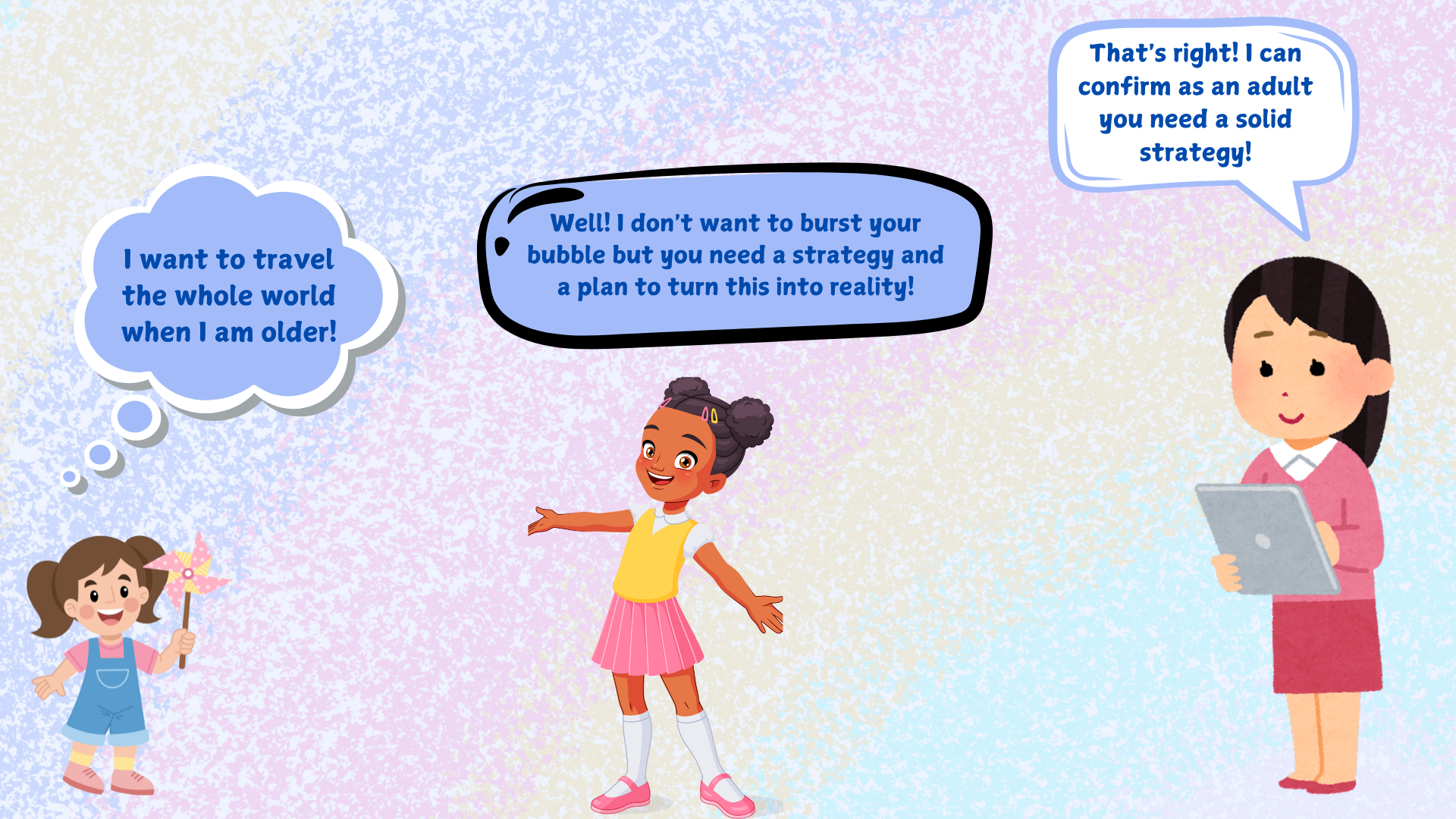
Step 1: Identify goals and objectives that are best aligned with your innate ADHD traits
What is your goal? What do you want to achieve on social media? Do you want to generate leads or drive traffic or sales within x amount of time?
I use the SMART (Specific, Measurable, Achievable, Relevant and Time-bound) framework to help me craft a strategy that is well aligned with my abilities and qualities as a digital marketer with ADHD.
For example, I know that I excel at creating engaging and visually appealing content. So, to leverage this trait, I aim to focus on creating visual content that will boost my engagement rate and traffic to my website.
Step 2: Choose the Right Platforms
There are so many social media platforms to choose from these days that it can be overwhelming for social media marketers with ADHD.
“If you are everywhere, you are nowhere” – Michel de Montaigne
Selecting platforms that align well with your natural energy and creativity is crucial. I prefer platforms like Threads and Instagram, where I can create short, dynamic content that stimulates my brain and motivates me to post.
Choose platforms where you can schedule and create content easily without extra effort.
Step 3: Create a Flexible Content Calendar
One of the biggest struggles of having ADHD is to stay consistent. It is like having a hundred content ideas in your mind but not being able to finish one!
I find it helpful to use tools like Trello or Notion calendar templates to help me organize my ideas and deadlines. Social media batching techniques can help you save time and allow you to work when you are at your best.
Scheduling content is one of the best methods to avoid impulsivity in your social media strategy.
However, leave some room for your creativity to flourish. I always have free slots on my content calendar for unplanned creative content.
Step 4: Implement the 80/20 rule
If you want to get better results without spending more time on your social media campaigns, the 80/20 rule is for you. This principle states that the largest share of the results – 80 percent is produced by just a small part of the work – 20 percent.
I usually use my hyperfocus state to do the 20% work that will get me 80% of the results. Similarly, if 20 percent of my customers generate 80% of my business revenue, I focus my efforts on identifying them and convincing them to keep buying.
This kind of 80/20 thinking can be applied to many areas in your social media marketing work and allows you to channel your energy in the right direction. Even though social media marketing for ADHD entrepreneurs can be tough, this simple principle can help.
Quick Takeaway Points
- Simplify strategic thinking and planning by answering three key questions – where you want to be, how to get there, and what you need to get there.
- Align your social media goals with your ADHD traits to get the most out of your work
- Focus on social media platforms that work for you and match your energy and creativity
- Create a flexible content calendar using tools like Trello or Notion that takes away the overwhelm and allows you to take creative liberties
- Apply the 80/20 rule to maximize results – use your hyperfocus state on high-impact tasks
Overcoming ADHD Challenges in Social Media Management
It has been a wild ride learning how to manage and overcome my ADHD challenges in social media management but I have learned a thing or two along the way that might help you get less cringe-worthy moments than me.
We all experience ADHD in different ways and we should not be quick to jump to comparisons on challenges each one of us faces but there are certain things you could do to make your work easier in this digital marketing space.
Let’s get right into it.
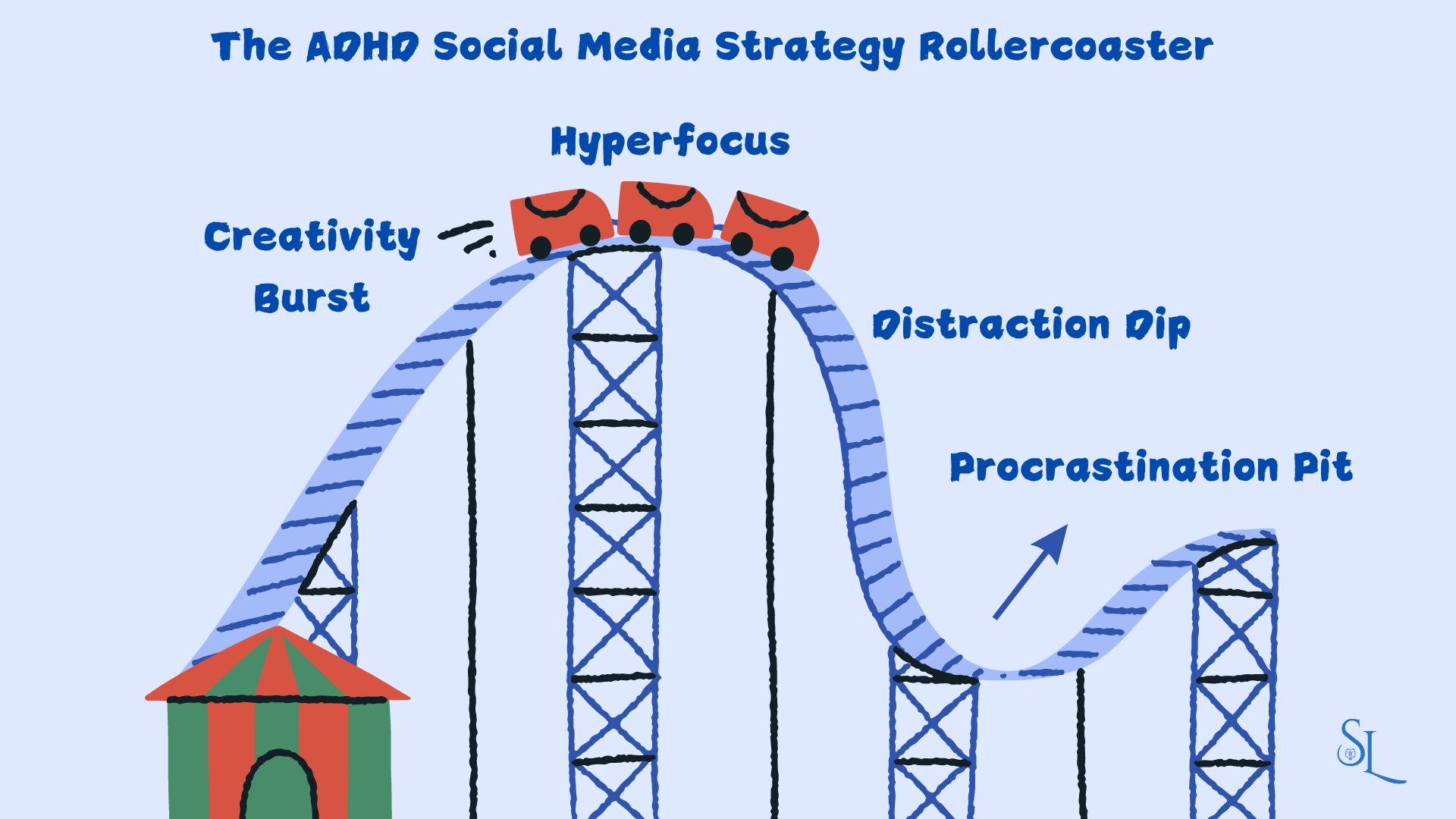
1. Overcoming social media distraction
How do you tame that notification beast? I did struggle with that one because our dopamine-seeking brain loves it. Imagine falling into a rabbit hole of social media notifications and short-form videos on multiple platforms… Social media and ADHD are usually the subject of hot debates.
To fix this, I took drastic measures such as automatic reminders to stop using a particular app for the day when I spend too much time on it and uninstalling addictive social media apps on my phone and using them only from my desktop.
At first, it felt like I was cutting off a limb or something. I thought that I would not be able to do my work properly but that’s a lie we often tell ourselves to justify the overuse of social media apps.
Believe me when I say it improved my productivity as I became more focused on doing my pending social media work once I logged in on my computer rather than spending aeons doom-scrolling.
Be strategic and set specific times of the day for engagement and checking notifications.
2. Taking control of your time
Time management for ADHD marketers is like swimming upstream – difficult but not impossible if you use the right techniques. I used to think I was just terrible at estimating how long things would take. Turns out, I’m not alone – it’s a common ADHD trait. Who knew?
To turn things around, I implemented many tips and tricks but the one hack that helped was the Pomodoro Technique. This lifesaver combined two things the ADHD brain loves: gamification of tasks and frequent breaks!
It is like a time game – 25 minutes of work and 5-10 mins break to rest though I found myself pacing around the room imagining movie scenes and dialogues most of the time. I know, sounds weird, but it works.
Use an app like Forest or Focus Keeper for a seamless visual experience.
3. Dealing with perfectionism and imposter syndrome in digital marketing
Social media marketers with ADHD often encounter the terrible monster of perfectionism in content creation that can eat up your day faster than my dog gobbles up unattended sandwiches.
You got where you are for a reason. Do not let imposter syndrome stop you. Think of it in this way – you only have to be one step ahead to teach someone. It is like an 8th grader teaching to a 7th grader!
I once spent 3 hours editing a reel that I wanted to be “perfect” but here’s the truth, in this fast-paced online space, being paralyzed by your mind is a huge disadvantage.
The best trick I have found is to set strict time limits for your tasks. For example, if I have to write a caption, I give myself 20 mins at most to do it. I use generative AI tools like Claude AI or Monica AI to help me organize my thoughts if I am lagging on my schedule.
AI is not here to take your job as a social media marketer but to help you do a better job and be faster.
4. Building consistency when your motivation fluctuates
This one’s tricky but with proper social media motivation techniques, you can craft adhd-friendly social media strategies that encourage you to remain consistent.
I think that consistency is one of the biggest challenges for individuals with ADHD and social media marketing is all about that, which makes this field even harder for us.
I achieve consistency by building routines. Like, really specific routines. Not just “I’ll post every day” because it never happens. The more specific you get, the better it is. For example, “I’ll devote 10 mins a day to engaging on Threads whilst drinking my cup of green tea”
I came up with this simple concept to help me out – minimum viable effort. This approach helps me to work on days when my motivation is in the gutter. I commit to one single thing.
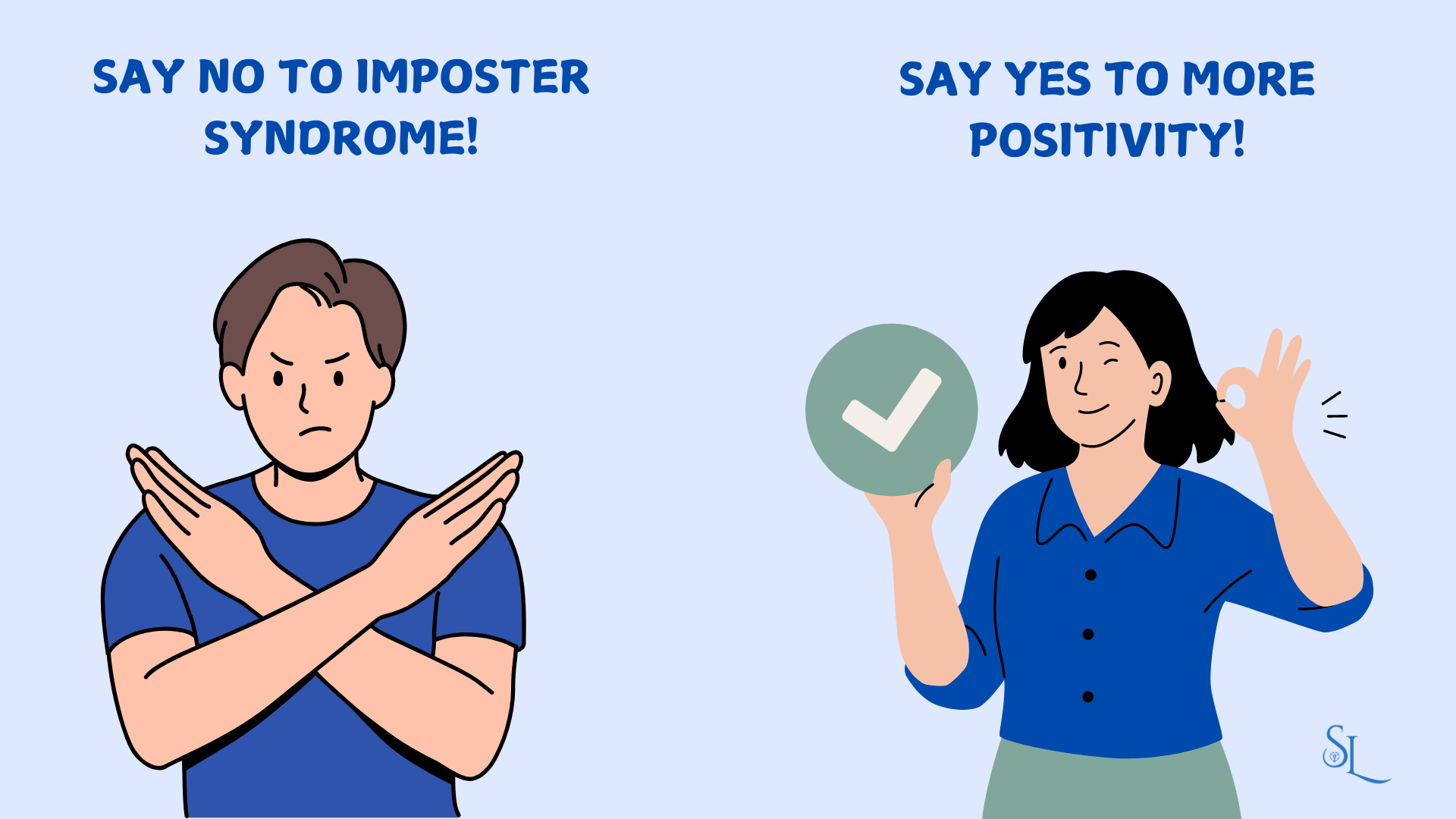
Here’s the ultimate advice I can give you as a digital marketer with ADHD: learn how to ride the waves of hyperfocus, high energy, high motivation and creativity. When I am in the zone, I always seize this opportunity to do the most impactful work in advance. Think of yourself as a squirrel storing its nuts for the winter.
Be easy on yourself, it is not always going to be perfect. There are days when you will feel like nothing is making sense but you should not give up. Focus on putting in the minimum viable effort.
Quick Takeaway Points
- Take away the social media overwhelm by uninstalling addictive apps from your phone and using them only on desktop
- Set specific times for specific tasks to maintain focus by using the Pomodoro Technique
- Use AI tools like Claude or Monica to ease the content creation process to overcome perfectionism and delays
- Build routines for your social media related work
- Apply the “minimum viable effort” approach on low-motivation days – commit to just one small task
Content Creation Techniques for the ADHD Mind
Content creation is probably the most fun part of my experience as a digital marketer with ADHD, because it allows me to unleash my ADHD superpowers. I can use my creativity to its full potential but let me make it clear, creating content with an ADHD brain can be a wild ride.
You could start your day churning out ideas like a pro, and the next you are staring into the void wondering what you were doing just now. Over time, I have gotten better at managing this and even if one would argue that AI is here to take our lives and jobs, I’d rather say it is here to help us be a better version of ourselves.
Buckle up, because I am about to spill the beans on how to make that ADHD mind work for you in the content creation arena.
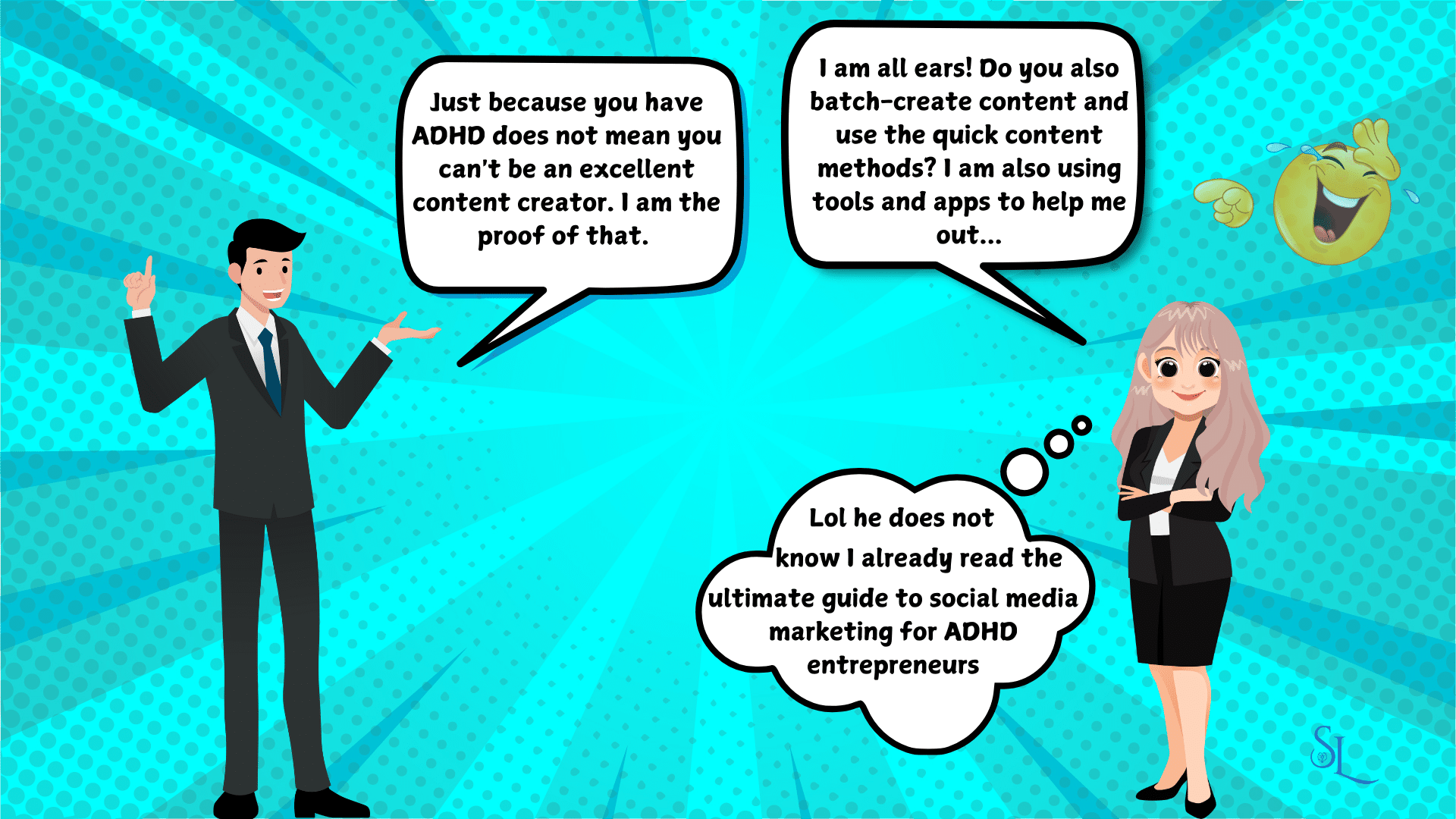
1. How to use ADHD hyperfocus in content creation
I want to make this as simple as possible, so let’s break it down with a simple anecdote. I remember the first time I watched a Chinese TV show and decided to learn Chinese overnight. That hyperfocus kicked in and it felt like I had gobbled up at least 5 cans of Red Bull. In the morning, I learned how to greet and meet in Mandarin, read Pinyin, and memorized the four basic tones.
The trick is to learn how to use your hyperfocus during brainstorming sessions. I have found that setting a timer for 25 minutes and challenging myself to come up with as many ideas as possible works wonders. The ADHD brain likes the gamification of tasks. If it is a challenge, it is surely game on!
But before you jump to work, preparation is key. You cannot expect to press a button and have your hyperfocus magically appear like some vampire-inspired hypnosis. You’ve got to be ready – I always have my notes app ready to write down ideas spiralling out of my mind.
Top tip: Gamify the content creation process and use your ADHD hyperfocus state to brainstorm new ideas using AI tools like Monica to refine your wildest thoughts.
2. Quick content creation methods
Let’s be honest, sometimes, you won’t feel like creating content. You won’t be in the mood for it. That’s when quick content creation methods can be handy. I can’t tell you how many times I have paced around my living room, talking into my phone record app like a crazy person, ideating my next “masterpiece”.
It is quite simple. Keep your voice note app ready, I use AI a lot in this aspect. I dictate my thoughts and get the AI to write a nice summary and even expand on my ideas.
Next up are templates: my lifesaver. I find myself using them more often than I should. Just plug and play. Make your life easier. I have a template for everything that has proven to work in the past – my posts, my viral hooks, my reels and blog posts.
I even use an application called Thriendly for my threads which already has templates for viral threads post. All you have to do is put your idea, and it will generate the content for you.
3. Using batching to make the most of your productive periods
Batching content is another technique I use to ensure I am taking advantage of my hyperfocus state and high-energy phases – yeah, it is better to take advantage of yourself than others! I once wrote social media content for 9 days on a particularly productive day.
Was I exhausted afterwards? Heck yeah but did I feel good about the 9 days of content I had ready to do? You bet! That’s how you use your ADHD strengths in digital marketing and there is no shame in doing this to avoid long-term overwhelm and inconsistency in your work.
How do you batch content? I typically approach batching by doing things in bulk for example, I might shoot a bunch of videos of myself on days I feel motivated to appear on camera. I use scheduling apps or the native scheduler on social media platforms to schedule my posts for at least a week if not a month!
4. Tools and apps that streamline the content creation process
Choosing the right tools and apps can be an overwhelming process in itself! There are so many wolves out there looking to capitalize on your ADHD brain! Just kidding! The appropriate apps and tools can truly help streamline your content creation process.
I’ve found a few apps and tools that have helped me over the years streamline my whole content creation process. Trello has been a godsend for organizing my content ideas in one place whilst keeping track of the deadline.
But here’s the one thing – all I can do is share what has worked best for me. It is your journey to find what’s best for you. I spent a whole week trying to make Evernote work for me because everyone said it was great for organization. Spoiler alert: it just made me more confused.
At the end of the day, creating content with ADHD is all about working with your brain, not against it. Some days will be easier than others, and that’s okay. The key is to have a toolbox of techniques you can pull from, depending on what your brain is up for that day.
Quick Takeaway Points
- Set timed challenges for brainstorming and use AI to refine your ideas
- Gamify your content creation process to stimulate your brain and motivate you
- Use voice notes and templates for quick content creation on low-energy days
- Take advantage of productive periods to batch-create content in advance
- Streamline your content creation process with tools like Trello
Engagement Strategies That Work for ADHD Brains
Do you struggle with that feeling that you have to be online 24/7 if you are a social media marketer? As someone with ADHD, I used to think I had to be responsive most of the time, respond to comments and reply to DMs the second they came. That was the perfect recipe for burnout!
I remember staying up very late to reply to every comment on a well-performing post. You can guess what happened the next day… A zombie looked better than me! Not exactly my finest moment as a content creator.
Here’s the bottom line: you do not have to sacrifice your health, sanity and time to be an excellent social media marketer and you should fall prey to the fear of missing out on genuine connections!
Let’s talk about the strategies I found to successfully manage your engagement effectively without the fear of missing out.

1. How to make genuine connections without getting overwhelmed
Engagement is a really valuable asset in social media marketing, which is why setting a specific time window for it is a must. I have my own “engagement hours” in place that are evenly distributed during the times of the day.
For instance, I dedicate 20 mins to Threads in the morning, 20 mins in the afternoon and 20 mins in the evening. The same applies to other social media platforms. The key is to analyse your metrics and check when your followers are mostly active.
And you know what? Your audience might appreciate knowing when they can expect to hear back from you.
2. Using your natural enthusiasm to build a loyal community
Building a loyal community is one of the primary goals of social media marketing. As a digital marketer with ADHD, when I am excited about something, it is like I can’t shut up about it. And I have learned to embrace this aspect of mine.
Your audience knows when you are genuinely passionate about something, and that energy is quite contagious. When I got diagnosed with ADHD, I was so interested in talking about it and creating awareness. I realized that many people like me wanted to talk about it. It was like my enthusiasm permitted them to be enthusiastic about it too.
You should not be afraid to be authentic when engaging with your audience. The outcome can be highly rewarding. Your true fans will appreciate you being the real you.
3. Implementing gamification to keep yourself motivated
As I mentioned before, the ADHD brain loves the gamification of tasks. This is how I get my daily motivation. There is growing interest in using gamification to engage and stimulate the ADHD brain.
I started using Habitica recently. It is an amazing platform to gamify your to-do list and turn it into a little RGP. Every time I complete a task, like responding to comments, I get XP or gold for my avatar. It sounds silly but it is highly rewarding and works for me.
There is something about seeing my game avatar level up as I complete tasks in real life. It hits my brain’s reward centre differently. Plus, if I slack off, my character takes damage – talk about motivation! It is a brilliant way to turn any boring task into a fun quest instead of a chore. I always say this “Social media marketing for ADHD entrepreneurs should NOT be boring!”
4. Automating engagement without losing authenticity
Automation is a tricky subject because many people think it takes away the authenticity of social media. Automation aims to save time and energy doing repetitive tasks.
I learned this the hard way when I tried to automate responding to messages or doing cold outreach with a generic greeting. Let’s just say the “Hey [NAME], thanks for reaching out!” messages didn’t exactly scream authenticity. It has changed the way I use automation in my business for engagement,
Here’s what I do: I use automation to share my posts automatically on social media platforms. So, it saves me time but still sounds like me because I wrote the message myself. Plus, I use Manychat to automate the delivery of freebies to my audience inboxes.
Finally, I also batch-create personal responses. They are text or email snippets I write in advance for common questions and answers. When you are feeling particularly chatty, you can write a bunch of thoughtful replies to common questions and comments and save them in a doc or text blaze to use later.
Quick Takeaway Points
- Set specific “engagement hours” throughout the day to manage social media interactions without burnout
- Analyze your metrics to determine when your followers are most active and engage during those times
- Use your natural ADHD enthusiasm to build genuine connections and a loyal community
- Implement gamification tools like Habitica to keep yourself motivated for daily social media tasks
- Automate repetitive tasks while maintaining authenticity by writing your messages in advance and storing them in a document
Analyzing Your Social Media Performance (Without Boring Yourself to Tears)
Do you ever feel intimidated by analytics? The A-word is dreaded for many reasons, one being that experts or analysts make it sound more complicated than it is. When I started my career as a digital marketer and ads strategist, hearing the word would make me want to run for the hills until I realized that it was a straightforward thing to do to boost your engagement and results.
Understanding your social media performance is crucial to growing your audience and making an impact. Most of it is common sense.
I found some incredible ADHD-friendly ways to approach analytics. So, let’s explore how you could do this effortlessly.

1. Set a specific time and day of the week for analytics
I set a weekly goal such as how much reach and engagement I would like to achieve for the week. I then pop on my favourite playlist, grab a cup of tea, and tell myself to look at and analyze the numbers for 30 minutes. Knowing that this time was already set and would end in 30 minutes, it made it less overwhelming for me.
The key lies in setting goals and reviewing if you achieve them with your content every week. For example, if I want to reach 50k people this week, I would see how much reach my posts were getting individually on average and how
2. Use visual tools to facilitate analytics
Why stare at numbers when you can create visually appealing charts that break down the information nicely? I use tools like Metricool, Meta Business Suite, and native analytics tools that present the data in charts.
It makes the numbers less boring and easier to interpret at one glance. Is my audience mainly male or female? A pie chart would help. When is my audience most active during the week? A bar chart helps.
3. Focus on metrics that truly matter
Anyone can get lost in the numbers and vanity metrics. Having ADHD makes it worse as we strive for perfectionism and want to be stimulated. There is a gazillion different numbers you could track but I learned to focus on the ones that help me grow.
These metrics involve engagement rate, reach, follower growth, shares, sales, and content-specific metrics. What is the use of likes if they do bring sales? What is the use of new followers if they do not engage or buy from you?
I created a reward system for myself. When I reach my weekly objectives, I reward myself for my little wins. It is amazing how motivating a chocolate milkshake can be!
Look, I’m not going to pretend that analyzing your social media performance is always going to be a piece of cake. By finding ways to make it visual, focusing on the metrics that actually matter, and turning it into a game, you can make it a whole lot less painful.
Quick Takeaway Points
- Set a specific time and day each week for analytics, limiting it to a manageable duration
- Create weekly goals for reach and engagement, then review your content’s performance against these targets
- Utilize visual tools like Metricool and Meta Business Suite to present data in easy-to-understand charts
- Focus on metrics that truly matter for growth, such as engagement rate, reach, follower growth, shares, and sales
- Implement a reward system for reaching weekly objectives to stay motivated
Self-Care and Burnout Prevention for ADHD Social Media Marketers
The hardest part of social media marketing for ADHD entrepreneurs is not the job itself; it is how easy it is to get burned out and overwhelmed by the constant struggle for results. Knowing about ADHD burnout and how to overcome it is essential.
I remember this one time, I was caught in an endless loop of low morale because of the pressure I felt from not taking action. It goes on like this: You do not take action for a day, feel low about it, do not get results, feel low again about it, do not take action because you feel low, and again you do not get results…. Does it ring a bell?
Or do you get so caught up in the job that you neglect your health, do not sleep well and end up looking like a panda without the cuteness? That’s when I knew I had to make some changes before I lose it. So, what did I do to make things better?

1. Learn how to recognise the signs of digital overwhelm
I like to use the boiling frog analogy to explain that one. A frog will not realize it is in boiling water until it gets too hot to get out. Before you get cooked in digital overwhelm, you need to recognise the red flags. I have a checklist I use to check in with myself:
- Am I constantly reaching for my phone, even when I’m supposed to be relaxing?
- Do I feel anxious or irritable when I’m not online?
- Have I forgotten what my family’s faces look like without a screen in front of them?
- Is my idea of “me time” just switching from work social media to personal social media?
If you are nodding along to these, you are cooked. Just kidding, you still have time to reverse this situation by going into social media detox for ADHD social media marketers.
Pinch yourself if you hear that little voice saying – “But I can’t just disconnect, I’ll lose all my followers!” Your followers are not more important than your mental health. If you are in poor mental shape, your followers and audience will be penalised as you will not be able to create great content for them.
2. Implement regular digital detoxes and boundaries
I set a “no-phone time” during the day and on special events. That’s right, no phone during breakfast , dinner time, movie nights, date nights (except for taking pictures), and no scrolling in bed. This radical change has great benefits; your brain won’t be buzzing with social media chatter.
I also use the Pomodoro method to focus on social media tasks that need to be accomplished during the day. The Focus to Do app forces me to turn my phone down once I have activated the timer to start working on a task. You can take 5-10 minutes breaks in between. Sometimes I wash some dishes, and sometimes I lift my cute little weights to refresh my mind.
2. Incorporate physical activity and mindfulness into your routine
Physical activity is a game changer. If you think you have no time for it, you are not giving it the importance it deserves. Exercises help the ADHD brain focus better. So now, I start my day with a 15-minute cardio session. I use the Just Fit app as it offers bite-sized cardio sessions.
Mindfulness is another lifesaver to improve focus and suppress anxiety. I know the idea of sitting still is not particularly attractive for someone with ADHD but if you give it a try, you will see massive improvements. I use Balance to do 2-minute sessions every 2 hours. It is better to start small than do nothing at all. Now, I can meditate for longer periods.
3. Build a support network of fellow ADHD entrepreneurs
As human beings, we need to understand our limitations and know when to get help. I joined an online group for ADHD entrepreneurs, and it has been helpful in various ways. We share tips, vent about struggles, and celebrate our wins. It’s like having a bunch of cheerleaders who understand what you are going through.
One of the best pieces of advice I got from this group was to schedule 10 minutes a day to let go of all my worries and shout if necessary to release the bad emotions. It helped me a lot in finding a release ground for tension and work my next moves for the day.
If things get out of hand, it is best to contact a health professional on the matter or a coach who can help you address your personal challenges with ADHD. You should never hesitate to seek the support and help that you need to get a better life.
Quick Takeaway Points
- Recognize digital overwhelm signs: anxiety, sleep disruption, irritability, and compulsive phone checking
- Create “no phone zones” and use the “Pomodoro method on steroids” for effective digital detoxes
- Join online ADHD entrepreneur groups to share experiences and get support
- Take regular breaks to recharge, ensuring you can continue creating amazing content for your followers
Summing Up On Social Media Marketing for ADHD Entrepreneurs
It has been quite a wild ride going through everything I have learned to make my life easier in my journey as a digital marketer with ADHD. This is my personal experience and it might be different for you but I hope these tips can help you!
I have created this social media marketing for ADHD entrepreneurs guide to help individuals like me become a better version of themselves like I did with myself.
Always remember, your unique ADHD brain is a gift in the creative world of social media – learn how to embrace the benefits, overcome your challenges and seek help when necessary.
If you would like to get monthly tips, tricks, and templates for free, subscribe to my newsletter for exciting organic marketing articles.


